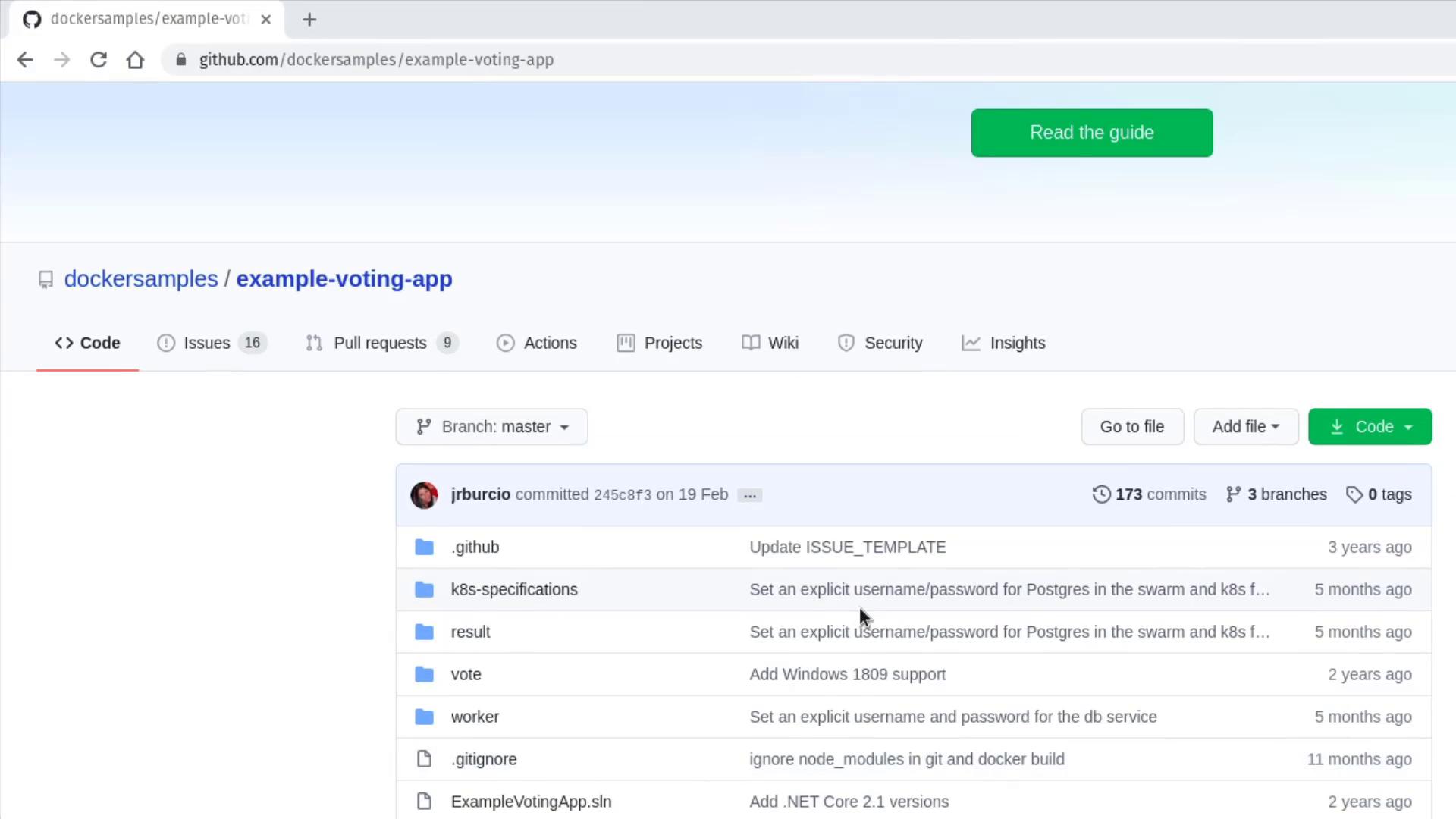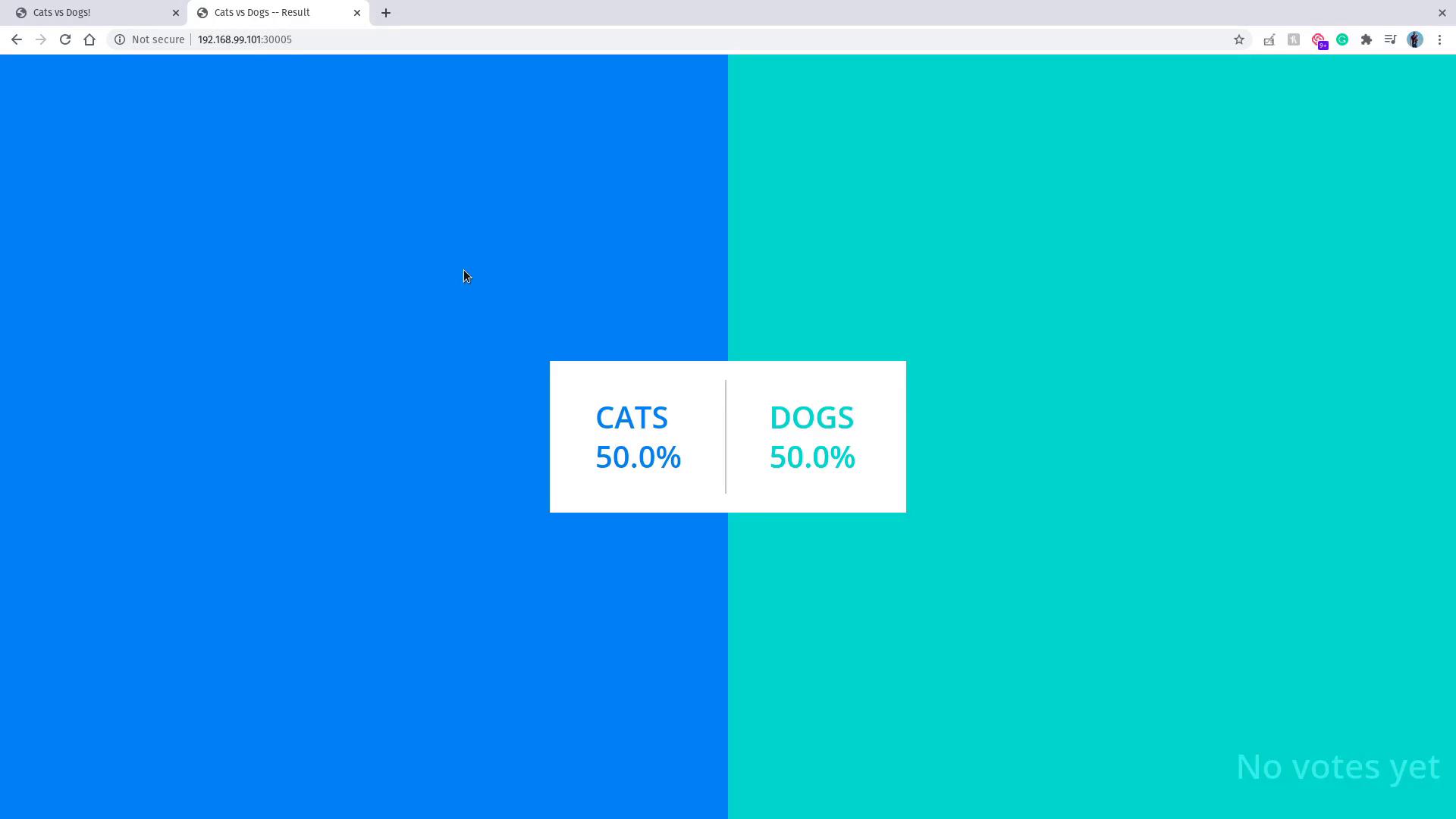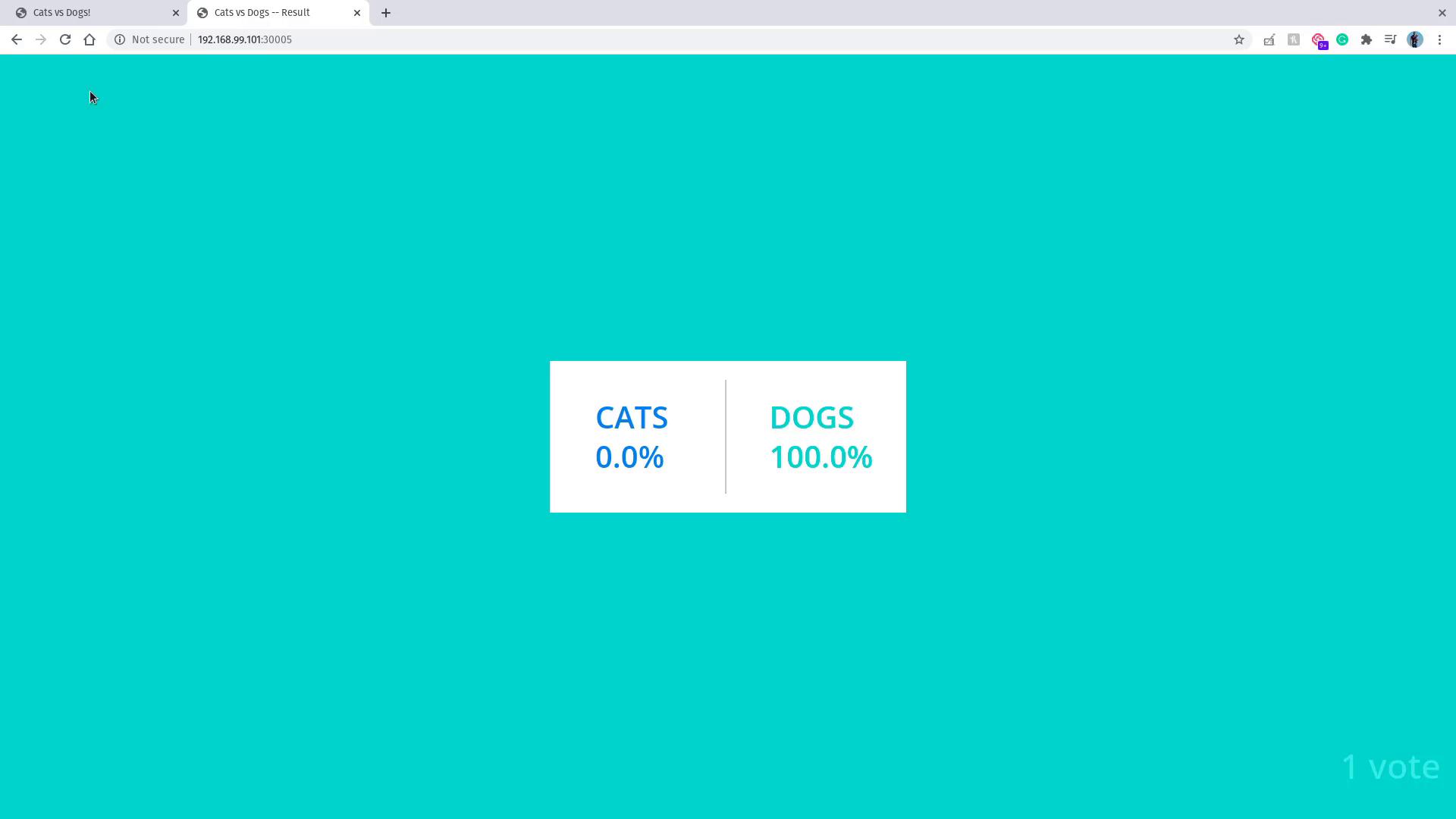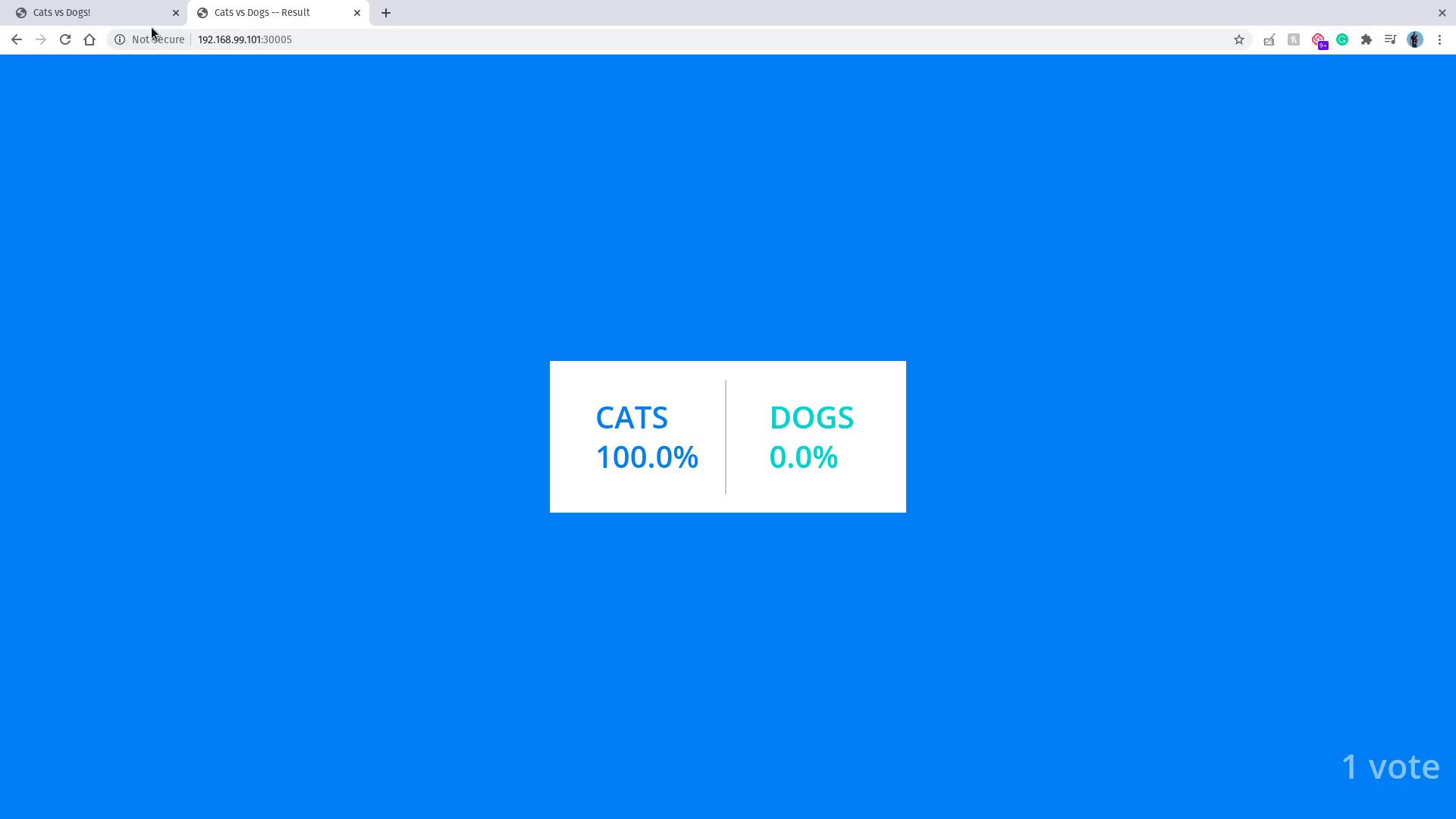Docker Certified Associate Exam Course
Kubernetes
Demo Deploy voting app on Kubernetes
In this tutorial, we’ll walk through deploying a multi-tier voting application on a Minikube cluster. You’ll define Pods for each component, expose them via Services, and verify end-to-end functionality.
1. Overview of Pod Definitions
All Pods use the label app: demo-voting-app to simplify grouping and service discovery.
| Pod Name | Image | Port |
|---|---|---|
| voting-app-pod | kodekloud/examplevotingapp_vote:v1 | 80 |
| result-app-pod | kodekloud/examplevotingapp_result:v1 | 80 |
| redis-pod | redis:latest | 6379 |
| postgres-pod | postgres:latest | 5432 |
| worker-app-pod | kodekloud/examplevotingapp_worker:v1 | — |
Note
Ensure you have Minikube running and kubectl configured to use the Minikube context before applying these manifests.
1.1 voting-app-pod.yaml
apiVersion: v1
kind: Pod
metadata:
name: voting-app-pod
labels:
name: voting-app-pod
app: demo-voting-app
spec:
containers:
- name: voting-app
image: kodekloud/examplevotingapp_vote:v1
ports:
- containerPort: 80

image: Hosted on KodeKloud’s Docker Hub.containerPort: Listens on port 80.
1.2 result-app-pod.yaml
apiVersion: v1
kind: Pod
metadata:
name: result-app-pod
labels:
name: result-app-pod
app: demo-voting-app
spec:
containers:
- name: result-app
image: kodekloud/examplevotingapp_result:v1
ports:
- containerPort: 80
- Grouped by
app: demo-voting-app. - Exposes port 80 for the results UI.
1.3 redis-pod.yaml
apiVersion: v1
kind: Pod
metadata:
name: redis-pod
labels:
name: redis-pod
app: demo-voting-app
spec:
containers:
- name: redis
image: redis:latest
ports:
- containerPort: 6379
- Uses the official Redis image from Docker Hub.
- Default Redis listens on port 6379.
1.4 postgres-pod.yaml
apiVersion: v1
kind: Pod
metadata:
name: postgres-pod
labels:
name: postgres-pod
app: demo-voting-app
spec:
containers:
- name: postgres
image: postgres:latest
ports:
- containerPort: 5432
env:
- name: POSTGRES_USER
value: "postgres"
- name: POSTGRES_PASSWORD
value: "postgres"
Warning
These credentials are hard-coded for demo purposes only. Do not use plaintext passwords in production.
- Exposes port 5432.
- Environment variables set
POSTGRES_USERandPOSTGRES_PASSWORD.
1.5 worker-app-pod.yaml
apiVersion: v1
kind: Pod
metadata:
name: worker-app-pod
labels:
name: worker-app-pod
app: demo-voting-app
spec:
containers:
- name: worker-app
image: kodekloud/examplevotingapp_worker:v1
- This background worker polls Redis for new votes and writes results to PostgreSQL.
- No ports exposed.
2. Service Definitions
Define Services to enable intra-cluster communication and external access for frontends.
| Service Name | Type | Port | TargetPort | NodePort |
|---|---|---|---|---|
| redis | ClusterIP | 6379 | 6379 | — |
| db | ClusterIP | 5432 | 5432 | — |
| voting-service | NodePort | 80 | 80 | 30004 |
| result-service | NodePort | 80 | 80 | 30005 |
2.1 redis-service.yaml
apiVersion: v1
kind: Service
metadata:
name: redis
labels:
name: redis-service
app: demo-voting-app
spec:
ports:
- port: 6379
targetPort: 6379
selector:
name: redis-pod
app: demo-voting-app
- Internal ClusterIP service for Redis.
2.2 postgres-service.yaml
apiVersion: v1
kind: Service
metadata:
name: db
labels:
name: postgres-service
app: demo-voting-app
spec:
ports:
- port: 5432
targetPort: 5432
selector:
name: postgres-pod
app: demo-voting-app
- Named
dbso the worker can connect usingdb:5432.
2.3 voting-app-service.yaml
apiVersion: v1
kind: Service
metadata:
name: voting-service
labels:
name: voting-service
app: demo-voting-app
spec:
type: NodePort
ports:
- port: 80
targetPort: 80
nodePort: 30004
selector:
name: voting-app-pod
app: demo-voting-app
- Exposes the voting UI externally on port
30004.
2.4 result-app-service.yaml
apiVersion: v1
kind: Service
metadata:
name: result-service
labels:
name: result-service
app: demo-voting-app
spec:
type: NodePort
ports:
- port: 80
targetPort: 80
nodePort: 30005
selector:
name: result-app-pod
app: demo-voting-app
- Exposes results UI externally on port
30005.
3. Applying Manifests
From the project root (e.g., voting-app/), create all Pods and Services:
kubectl apply -f voting-app-pod.yaml
kubectl apply -f result-app-pod.yaml
kubectl apply -f redis-pod.yaml
kubectl apply -f postgres-pod.yaml
kubectl apply -f worker-app-pod.yaml
kubectl apply -f redis-service.yaml
kubectl apply -f postgres-service.yaml
kubectl apply -f voting-app-service.yaml
kubectl apply -f result-app-service.yaml
Verify that everything is running:
kubectl get pods,svc
4. Accessing the Application
Retrieve the external URLs for the frontends:
minikube service voting-service --url
minikube service result-service --url
# e.g.: http://192.168.99.101:30005
Open the voting UI in your browser to cast votes, then navigate to the results page.
5. Testing the Voting Workflow
After submitting your first vote for “Dogs” you’ll see a 50/50 split:

Viewing results immediately after one vote:

Casting another vote for “Cats” updates the results in real time:

Congratulations! You’ve successfully deployed and tested a complete multi-tier application on Kubernetes. For more details, refer to the Kubernetes Documentation and Minikube Guides.
Watch Video
Watch video content